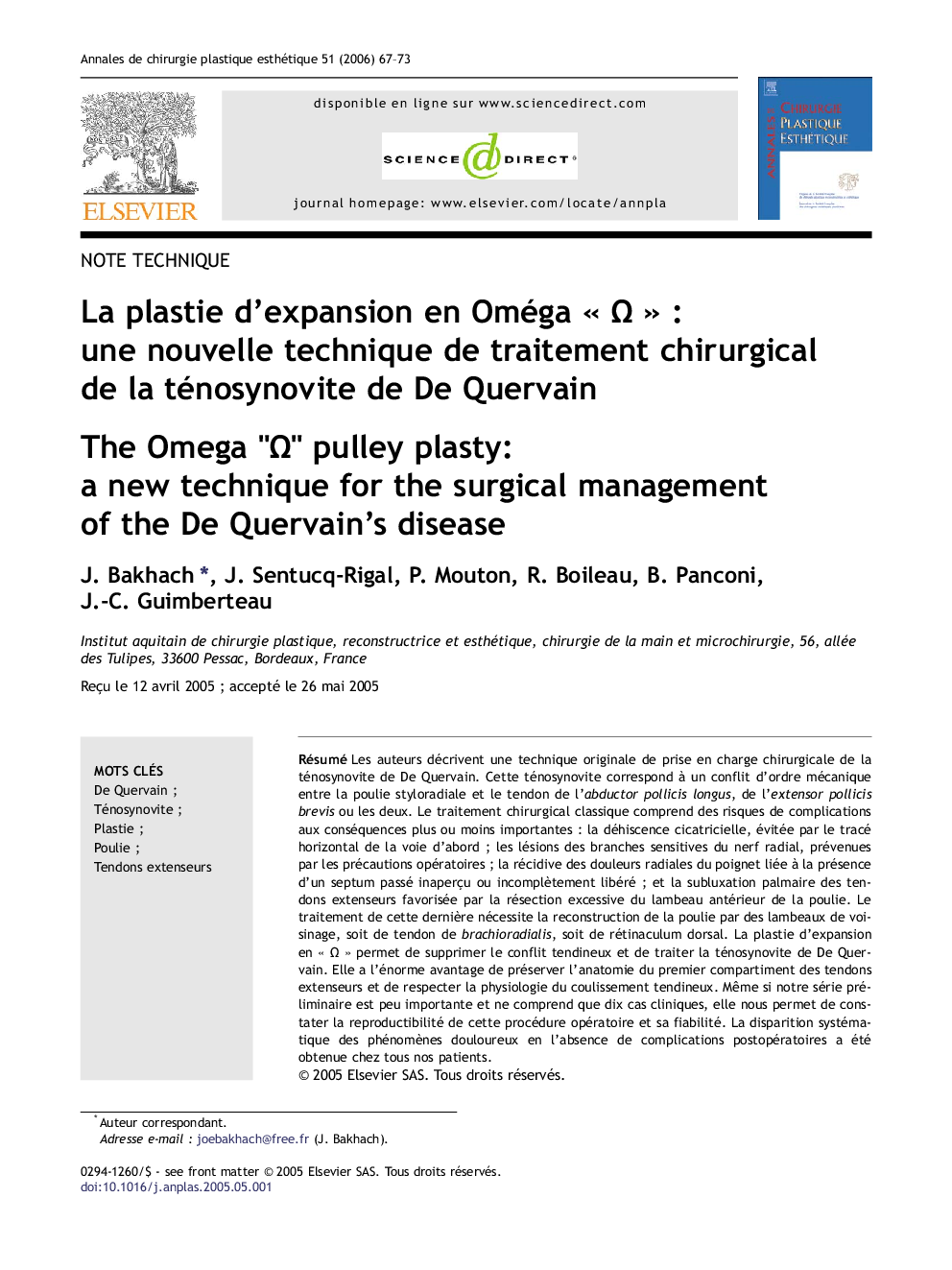| Article ID | Journal | Published Year | Pages | File Type |
|---|---|---|---|---|
| 3185485 | Annales de Chirurgie Plastique Esthétique | 2006 | 7 Pages |
RésuméLes auteurs décrivent une technique originale de prise en charge chirurgicale de la ténosynovite de De Quervain. Cette ténosynovite correspond à un conflit d'ordre mécanique entre la poulie styloradiale et le tendon de l'abductor pollicis longus, de l'extensor pollicis brevis ou les deux. Le traitement chirurgical classique comprend des risques de complications aux conséquences plus ou moins importantes : la déhiscence cicatricielle, évitée par le tracé horizontal de la voie d'abord ; les lésions des branches sensitives du nerf radial, prévenues par les précautions opératoires ; la récidive des douleurs radiales du poignet liée à la présence d'un septum passé inaperçu ou incomplètement libéré ; et la subluxation palmaire des tendons extenseurs favorisée par la résection excessive du lambeau antérieur de la poulie. Le traitement de cette dernière nécessite la reconstruction de la poulie par des lambeaux de voisinage, soit de tendon de brachioradialis, soit de rétinaculum dorsal. La plastie d'expansion en « Ω » permet de supprimer le conflit tendineux et de traiter la ténosynovite de De Quervain. Elle a l'énorme avantage de préserver l'anatomie du premier compartiment des tendons extenseurs et de respecter la physiologie du coulissement tendineux. Même si notre série préliminaire est peu importante et ne comprend que dix cas cliniques, elle nous permet de constater la reproductibilité de cette procédure opératoire et sa fiabilité. La disparition systématique des phénomènes douloureux en l'absence de complications postopératoires a été obtenue chez tous nos patients.
The Omega "Ω" pulley plasty: a new technique for the surgical management of the De Quervain's disease. The De Quervain tenosynovitis is an inadequacy into the first extensor compartment between the osteo-fibrous tunnel and the tendons. This mechanical conflict generates a tenosynovitis of the extensor pollicis brevis and the abductor pollicis longus tendons. This is generally expressed by a tenderness on the radial side of the wrist over the radial styloid process. The medical management consists on corticoids infiltrations of the first extensor compartment, the avoidance of repetitive and stress movements of the first ray with the use of a rest splint. The surgical approach is considered with the recurrence of the painful symptoms. This well-known pathology is reputated to require a simple section of the pulley. Our post-operative complications have been reported in the literature of this classical surgical solution. These complications concern an incomplete release of the extensor pollicis brevis and the abductor pollicis longus tendons particularly when an extensor sub-compartment exists and was overlooked, an irritation of the collateral branches of the sensitive radial nerve or the occurrence of a nevroma after a nerve injury and the most serious complication is a palmar subluxation of the extensor tendons which can occur with the thumb extended and the wrist flexed. In rare cases, this subluxation can be really painful and requires a surgical management with secondary reconstruction of the pulley. This reconstruction necessitates distal pedicle flaps from the dorsal retinaculum or the brachioradialis tendon. To prevent these complications, Codega and Kapandji described techniques of reconstruction of the pulley after its release. More recently, Le Viet reported a procedure using the anterior flap of the pulley; fixed to the dermis it will work as a barrier and maintain the tendons sliding on the radial styloid groove. These techniques require to divide the pulley and to reconstruct it suturing the different flaps. It can generate adherences between the extensor tendons, the overlying skin and the collateral branches of the radial nerve. The authors present a new and original plasty procedure of the first extensor compartment pulley, the "Ω" Omega plasty. It consists to liberate the anterior attachment of the pulley over the anterior lip of the styloïd process respecting its continuity with the periosteum flap. This conservative procedure is very interesting; it permits enough expansion of the tunnel volume decompressing the extensor tendons as a treatment of the De Quervain disease and respecting the anatomy and the continuity of the osteo-fibrous tunnel. This technique is simple, reliable and respects the first ray extensor tendons gliding physiology and biodynamic. In spite of our short clinical experience with only ten cases, all the patients retrieve a normal function of the thumb with complete disappearance of the first ray tenderness and pain without any complications. These preliminary results are encouraging and push us to consider the "Ω" plasty as a first choice for the surgical treatment of the De Quervain tenosynovitis.
